
Coming up with great titles for artwork can be a real drag. Many artists feel like it’s more work to come up with a title than it is to create a masterpiece. If you were a natural wordsmith you would have become a poet, not an artist. So, the question is do titles really matter, and how much time and effort should you spend titling your work?
From a gallery owner’s perspective, I can tell you that I do believe titles matter. A buyer wants to feel like that artwork they are about to purchase from you is one of your best ever – that it truly is one of your masterworks. They’re going to have a hard time believing that if you’ve called the piece “Untitled No. 427.” A good title becomes a part of the buyer’s narrative. A particularly good title will help sell the artwork. Conversely, a bad title can hamper sales.
So what makes a good title, and how can you come up with good titles without going insane? I have some suggestions, and I would love to hear yours (leave them in the comments below).
What Makes a Good Title?
Titling your artwork is a challenge because you have several potentially conflicting goals with a good title:
- A good title will provide insight into your inspiration for the artwork and may help the artwork tell its story.
- A good title will leave room for the viewer to bring his or her own meaning and interpretation to the artwork.
Additionally, a good title will
- be memorable and catchy
- be original (or at least as original as anything can be in a world where nothing is ever truly new)
- not be too cheesy
How to Come Up with Titles
So the goal is to come up with a great title – but how does one do it? After having dealt with tens of thousands of pieces of art and having spoken with hundreds of artists about titles, here are some ideas I’ve come across that might help:
- Start with the obvious – if there are elements in the artwork that are key focal points, use those elements as a jumping off point.
- Was there a driving emotion or inspiration that lead you to create the work? If so, try and draw a title from that inspiration.
- Is there an underlying story behind the work? Try to clue the buyer into the story with your title.
- Try to put yourself in your viewer’s shoes – what will they see when they look at the work? What do you want them to focus on?
- Keep it short. While there are obviously exceptions, if you need a 30 word title, you are probably doing something wrong (and maybe you should have become and author instead of artist!)
Coming Up with Titles Can Become More Difficult over Time
This all sounds great in theory and will work for the first dozen or so pieces an artist creates, but what about after you’ve created hundreds of pieces? Eventually you are going to run out of creative, unique titles. To combat this issue, try to come up with a naming system. I’ve known artists who look to poetry or mythology for inspiration. Having a dictionary and thesaurus around can help. Get help – my mother helps name most of my father’s paintings.
Examples of Great Titles
Here are some examples of works that I feel have strong titles.
Lorri Acott, an artist I represent in my gallery is a master of titling her artwork. Here are a couple of the best examples of her titles.
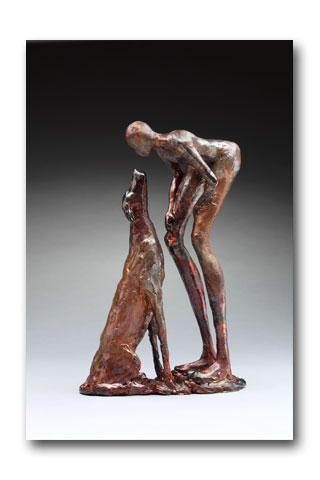
Who Rescued Who? by Lorri Acott
The piece of sculpture is fun and engaging by itself, but the title adds a whole new layer of meaning to the art. One night at artwalk I observed a couple looking at this piece.
“Look at this one,” the husband said.
“I love it,” replied the wife.
“Now look at the title.”
“‘Who Rescued Who,’ Oh, I love it.”
“The title makes the piece,” said the husband. The wife agreed.
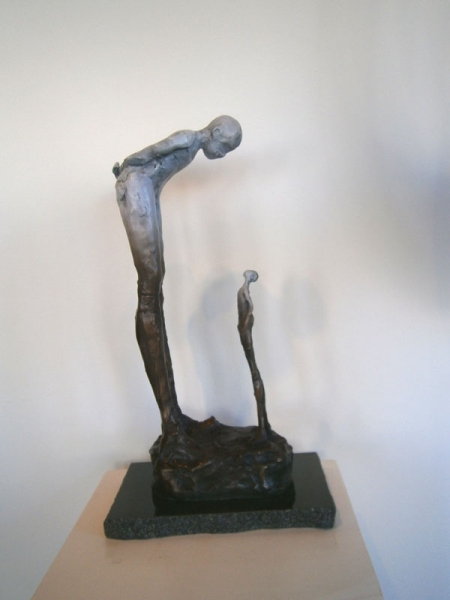
Conversation with Myself by Lorri Acott
Again, the title makes you stop and think, and the more you think about it the more intriguing you find the piece.
“Okay,” you are saying, “so there are a couple of brilliant examples, but my work doesn’t lend itself to those kind of title fireworks – how about some more down to earth examples?”
You have a point – here are some strong, but simpler titles:

Aspen Elegance by John Horejs
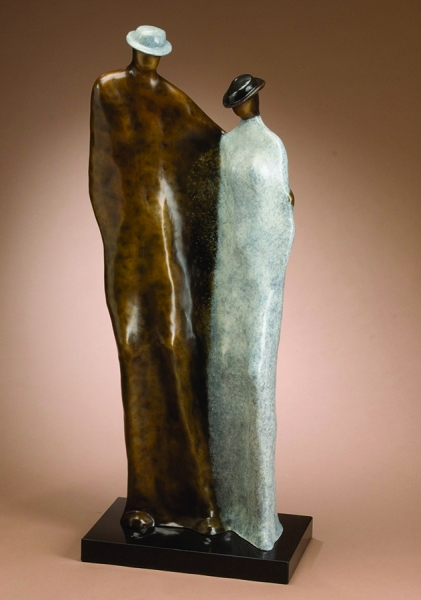
Commitment by Guilloume
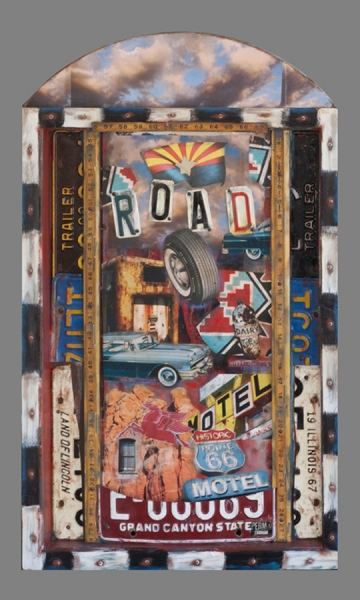
Chicago to Arizona by Dave Newman
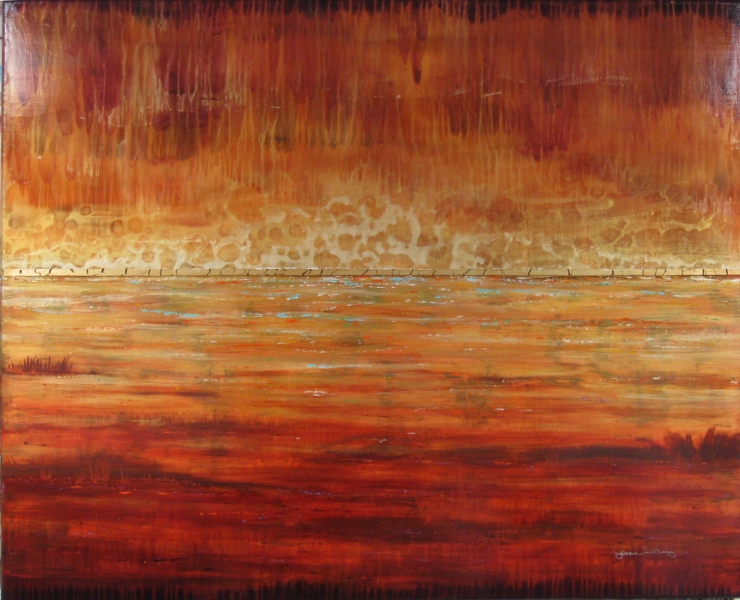
Desert Flame by Josh Wiley
What Are Your Thoughts About Titles?
Do you struggle when titling your artwork? Have you come up with a great system for titling your artwork? What would you suggest to other artists who struggle with their titles? What are some of your favorite art titles ever? Share your experiences, challenges, and ideas in the comments below.
Did You Find this Post Helpful?
If you found useful information in this post, please share it on your favorite social media platform or send a link to an artist friend via email. Thanks for sharing!
Great article Jason. I often have no idea what the subject of a painting will be at the start. The painting reveals to me what it should be.
With most, the title also reveals itself with relative ease. Some however, never seem to have a great title even after much thought. I hate those few that may be excellent paintings but a really fitting title simply eludes me.
That’s when you ask your facebook / mailing list / IG fans to help! They love it and you get some really lovely interpretations and names
My work tends to be austere and abstract so I like to give the viewer “a way in.” In the titles as much as in the work, I try to evoke without prescribing.
If working in a series, I name the series and number the individual pieces –as though they were prints even though they’re not prints. For example, a couple of years ago I made 100 smoke drawings and was listening to Otis Redding all the while. The series is Try a Little Tenderness 001-100.
My stand-alone works tend to have something in common, howsoever loosely. For example, I have some linear works with water-related titles such as “Flood Plain” and “Time and the River.”
In between a standardized series and stand-alone works I have a few works that are connected in that they are inspired by poems. These are all “Lauds” followed by something that acknowledges the source poem, as “Lauds: It doesn’t have to be the blue iris” (from the poem “Praying” by Mary Oliver).
Great ideas! Sometimes I pay more attention to the names of my paintings, sometimes less. But if it is so important, then there is a serious reason to think. Besides, I really like writing poetry. Now it makes sense to pay more attention to the names. Thanks!
Sometimes paintings whisper their own names to me, but after 100’s of works, it gets harder and harder to be original.
Something that works well for me is to ask my followers and mailing list for suggestions.
They love it, and I keep a list of good suggestions.
When I use one I credit the namer, to finish the positive feedback loop.
I find that including sufficient location data in the online title and ADA metadata helps new customers find me in their internet searches, but I might put it in parentheses after the hopefully catchy title. Whether the showroom tag needs to be short is my question? Some visitors may know the view that triggered the painting, others not. For example: View from the Trail (across Drake’s Bay, Point Reyes National Seashore). I’m accessing your advice with the short title explaining the inspirational adventure, and the mixed perspective looking down on a Park building yet also across to cliffs and up to clouds.
It’s even more difficult with abstract pieces. Although I start with an intention, I let the painting take me where it wants to go. I usually stick with the first title that pops into my head when I’ve decided it’s finished. It seems much harder when I agonize over it. With non-objective work, you don’t want to create a title that leads the viewer to decide it’s “something”. You want them to see whatever they see in it.
Maybe abstracts can be titled “Figure it Out” or “Figure it Out for Yourself” or “Your Guess is as Good as Mine” or “What Do You Think?” or “It’s Up to You”.
I always thought it was easier for abstract artists – they can change the title to anything they want. When curating themed shows, I sometimes feel that the artists think they can put any painting in and make up a title while more realist based artists expect to have something recognizable in their painting that relates to the theme.
I paint a lot of paintings of specific landscapes that are exhibited in the area in which they are created. The dilemma is when to title the work with the specific location which might attract a buyer who identifies with that location and has a relationship with that view…or does it turn off the viewer who might look at the work and imagine it is in a familiar locale or experience of their own having nothing to do with the specific named place in the title? Sometimes I find it best to do the loose title of “Fall Landscape” or “Birches in Winter” and let the viewer enjoy the work in of itself rather than being directed to see if it looks like that specific place named in the title.
A lonnnng time ago, I did a thumbnail of the reservoir on MacArthur Blvd in D.C. Over the years, I have done 7 paintings from that sketch, different seasons or times of day. I have sold it 4 times. Each sale was to someone who grew up by, or spent summers by, THAT lake…4 different states. The first time surprised me since there is a rather noticeable but small tree in all the paintings.
I accidentally let the first buyer assume that the painting was indeed of her lake. As she walked off with the painting, that was an “aha” moment for me. Unless it is something that is immediately recognizable, like the Washington Monument or the Eiffel Tower, I don’t tell ’em the location of the piece. Let ’em love it for what they bring to the piece.
p.s. the other 3 are with family, including one in my house that I love to look at.
Hi Jason –
Being that I produce a huge volume of work, and often many variations of a “main image” I have a big problem with titles, especially if a work is part of a series, but still depicts something slightly different, that I want to have a separate title for – but after reading this and rereading it, I’ve decided going forward, to put the most expressive description as the main title and perhaps have a more prosaic but defining title in parentheses [eg: “Futuristic City 5 (Geometric 2022 – 33b)” ] – I need the 2nd for cataloging purposes as it relates to the other geometric 2022 – xxx artworks and needs to be filed with them). But your article make a very strong case for a great “story-telling” title, and I’m going to produce more of them. I think its absolutely great advice!
On a separate note – your father’s artwork “Aspen Elegance” is an absolutely great artwork, one of the absolute best “forest and trees” works I have ever seen (and I have seen a real lot of them, loving many I’ve seen before) – it was immediately reminiscent of several of Gustav Klimt’s artworks, Tannenwald I (1901) and Forest of Beech Trees (1903) in particular – I consider this to be very very high praise as Klimt was a master of forest depictions (just this week, one of Klimt’s forest paintings “The Birch Forest” sold for $104.6 million at Christie’s auction of Paul Allen’s estate artworks!)
My work is almost all geometric abstracts but because I once had a naming contest on Facebook at the start of COVID of 19 paintings, all my Facebook friends feel free to offer names on everything I post now, whether I ask or not. A lot of the names are better than anything I think of. If I do use a name, I tell the person that I’m using it and recently that almost turned into a sale.
The painting reminded her of skiing and she skis in Maine at Sugarloaf. I’ve always thought that was a fun name, so I named it Sugarloaf and let her know. Then she wanted to buy it for a friend whose house she uses there. It turned out to be too expense for a gift, but she said she might buy it for herself. Meanwhile an outdoorsy friend of my daughter commented to me, “I love seeing your art of Instagram. I really like that Sugarloaf one.”
I love creating titles for my work! In fact, the title emerges while I’m painting and informs the finished product. Clients (and social media fans) tell me that my titles draw them in as much as the art does.
My advise – throw out all of the rules, don’t worry if your title is too long or too short, or if your title will appeal to everyone – your ideal client will connect with it, and that’s all that matters. Most important – have fun naming your pieces!
Here are two of my titles to show the range of what works for me and my niche client (and yes, there is a period after Moo. just to add some humor)
‘Moo.’
‘She Looks In The Mirror And Sees A Goddess’
Elements in the artwork that are key focal points.This will help elaborate more on the artwork since the title is influenced by the work.
I now have different approaches to get Great Tittles.
Thanks Jason
I work a bit on a piece then hang it on a “drying wall” while I work on another. Because I talk about them with my husband, I give them off the cuff names. Most times, those names stick. Thus, a painting of the Black Canyon of the Dennison became The Red Tower, or a painting of an appealing (to me) stump became Castle Stump…well, it IS reminiscent of a Norman castle.
The idea of getting names from viewers is brilliant!
I haves an annual contest to name my first major work of each year and got close to a thousand suggestions. It involves my collectors and makes them feel a part of the creative process. My other titles often come as I am working on the piece and sometimes before I start painting. The creative process requires a relaxed mind and when I get stumped on a title, I stop trying and often , the right title just pops into my head when I least expect it!
I love leaving the title for all my paintings. I believe that the title can draw viewer in to search your work. Thank you for the advice. I am an eclectic painter, makes media collage artist.
I agree wholeheartedly. Titles can and do help close a sale that could go either way otherwise. I once had someone who said emphatically that they couldn’t afford a piece, buy it because the title contained the fragment of a common idiom their relative was fond of using. A title can add that touch of humor or pathos just at the right moment for someone.
Excellent suggestions from Jason and others. This was something I have trouble with, feel like I use the same names over and over since I paint so much ‘water’ (in its natural habitat, of course!).
A lot of my paintings start with a title, the inspiration for the creative process. Other times I just start and the name/title just comes to me. I agree,most paintings I sold is where ,they could relate and were drawn to the image and title .Since I work in different media ,my work is different in everyone of them but the subject matter is the same. For me it’s not difficult to title,it is just part of it , it’s listening to my soul, it’s not separate from my paintings or drawings.
Yes, titling a piece can come easily, or be very tricky. I admit, though, that I’m hesitant to ask others for suggestions. I feel the creation process — of painting as well as naming — is mine and mine alone. I keep a running list in my phone’s notes app of words, phrases, and ideas for titles that can help spark a title when i feel stuck.
And having just attended a public reading a couple of nights ago by the crazy talented, insightful, and creative U.S. Poet Laureate Ada Limon, I offer this about poets: When they’re really good, they are indeed artists.
Great article, Jason. I keep a list of titles from things I’ve heard, read, from lessons from my spiritual center, etc. Sometimes I have to let a piece hang in my studio for a while, and a title will strike me.
Oh most definitely helpful. I had no idea that it mattered that much. I more less was titling to help with me with my inventory especially when I tend to do several pieces over and over with different variations, as in stains and colors. I love the idea of asking for help, getting my fb followers engaged!😉
I appreciate your time.
I love, and have written about, jazz. Titles for my abstract expressionist paintings are the names of jazz tunes. I don’t try to paint a particular tune. I let the work suggest a name when the painting is finished. It’s a gratifying link between two loves of my life.
At my last solo show there was a gentleman who seemed to be spending an inordinate amount of time going from painting to painting.. of course I didn’t want to interrupt him.. but when he stepped back I came up to him smilingly said who I was and thanked him for being there and I said “Would you please tell me what it is this attracting you to this particular painting?”
… and he said “The title.. all your titles!”
Now of course I wanted him to talk about my art but what he said stuck with me..
As well as being an artist, I have been a writer most of my life and I have become a serious word collector.. if I’m listening to a piece of music, reading a novel or a poem, or even see a terrific advertisement and some word or phrase resonates with me I keep it with my collection..
And when I finish a painting and it sits with me for a while, if a title doesn’t jump out at me I go to my word collection and inevitably I find something that is perfect match.
Good ideas!
Most of my work is a result of feelings, emotions, experiences in my life. I don’t usually title a piece until I am done, because things change and where I am one day may not be there the next. Sometimes I write down thoughts when I leave a painting for another day to complete. These notes can help me return to my state of mind of where I was when I stopped. In a more recent sale, a new client fell in love with my painting because it reminded him of Denver, CO where he grew up. The title: Winter at Play. I love snow and winter and so rarely get it here in the East, but all the while I painted that painting I thought about how much fun Winter is….It was a VERY abstract painting…..
Good article, mazel tav! I find that, in writing, my personal experience works better than the impersonal, such as, an analysis of one thing or another, so I bring that thought along with me to the point of titling.
What’s interesting to me, is when starting a piece I invent a working title, something I can refer to with on-lookers or models I work with … and then magic makes its appearance with the finished piece, where I find my intimate relationship with the piece to be very personal. I won’t name a piece until this comes to me. It may ble that a casual viewer finds it difficult to relate to the piece beyond its artfulness and it becomes a mystery that could go unsolved for hundreds of years or even not at all.
I think of Gauguin, titling his pieces in Tahitian and his viewers complaining. He really didn’t care, and neither do I, as I feel I didn’t do the piece for them, but for me in the first place. I think one must have an interest in me and what I’m doing before they are even slightly interested in my art. If one investigates my life further, one might even stumble upon the meaning in a title.
If I was to produce a piece primarily to sell, I’d need to name it “I Did This Piece in a week to Put Bread on the Table”, and then, if they paid $2000 for it, they would half that, knowing a gallery would split the cost to them and I would make $1000 per week, an average salary if average is $50,000 per year and they eventually would do the math and appreciate at least, the honesty that they are being faced with, appreciate that, and not feel like they were overcharged for my work.
Last year, I asked my Facebook friends for help to come up with a caption for my Christmas Card. I got some great responses, and used one of them.
Most of my paintings are landscapes, and it’s easy to give them titles.
I also have an ongoing series of paintings that are inspired by the classic Universal Monster Movies. For these, I have combined a recognizable location with something unusualy going on. I usually have the title in-mind before ever picking up a paint brush. Here’s a few examples…
The Creature From The Black Lagoon Goes Waterskiing at the Chesapeake Bay Bridge
The Creature From The Black Lagoon Watches Vikings Launch at the Lapidum Boat Ramp on the Susquehanna
The Blob Has Become a Regular at the Gym
Bel Air Nocturn – Wolfman is About to Discover That The Sheriff Uses Silver Bullets
Their Romantic Hike is About to Be Interupted By The Angry Villagers From Last Night
The Moment When Dierdre Realized That Her “Perfect Date” Was a Vampire
If you’re interested in seeing them, my website is: fromscottsperspective.com
Titles are very important to me, and I agree about them needing to hint at the story so the viewer has room to infuse their own story.
I recently started a new series of landscapes with titles taken from phrases in some of my favorite hymns. These are anchor phrases that bring a sense of awe. At first it was easy. I would see a scene that reminded me of a song and paint that. Now I’m doing the opposite; listing key familiar phrases and then looking for opportunities to flesh them out…much like an illustrator does.
It seems to be working well for me as several of them have sold.
As a landscape painter I can always fall back on the location. However I do try to find something more creative such as the emotion that that moment evoked, a memory it triggers in me, whats different that day than any other days at that location. I also keep a file of interesting names I think I can use in the future. Since I exhibit in several themed shows I often change a title to relate to the theme of the show. Simetimes its better than the original title. I do ask others for their suggestions and do use them sometimes.